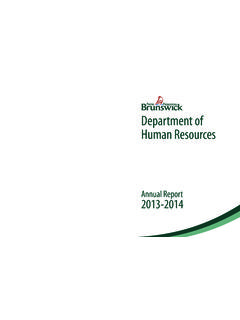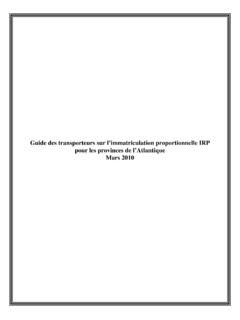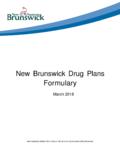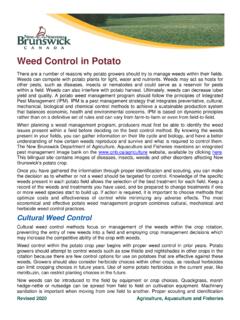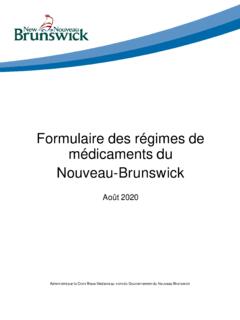Transcription of Fact Sheet on Sodium Chloride in Private Drinking …
1 Fact Sheet - Salt in Private Drinking water Wells Sodium and Chloride in groundwaterSodium and Chloride occur naturally in groundwater. However, sources such as road salt, water softeners, natural underground salt deposits, pollution from septic systems as well as salt water intrusion due to proximity to the ocean are often causes of elevated levels in Drinking water supplies. This could be a health concern for people on low Sodium diets. Elevated levels of Sodium and Chloride can also interfere with taste, the watering of certain plants and may increase the corrosivity of the water and damage household plumbing.
2 : Higher than normal levels of Sodium Chloride would likely cause corrosion and shorten the life of plumbing, hot water heaters and any appliances that come in contact with the water . The aesthetic objective for Chloride in Drinking water according to the Health Canada Guidelines for Canadian Drinking water Quality is less than or equal to 250 mg/l. Chloride concentrations greater than the guideline usually produce a noticeable taste in Drinking water however if the concentration increases gradually, it may be more difficult to detect.
3 Furthermore, the aesthetic guideline for Sodium in Drinking water is greater than or equal to 200 mg/l. The Sodium guideline for people on Sodium restricted diets is 20 mg/l. The only way to know the concentration of Sodium and Chloride in your Drinking water is to have your water tested by an accredited laboratory. Please visit the following Health Canada Website for more information on acceptable levels of Sodium and Chloride in Drinking water : How do you know if you have elevated levels of Na & Cl in your Drinking water ?
4 How Does Salt End Up In Groundwater?: If your well is located in relative close proximity to a road or road salt storage facility, it may be at risk of becoming contaminated. If you have high levels of Sodium and Chloride in your well water (especially in the winter months) and you suspect that it may be due to road salt, here are some things you can do: Contamination from Road Salt: Verify if your water is salty on a seasonal basis or if it s salty year round. Verify that your well is located at the required minimum distance to a Right of Way of a public road as required in the water well Regulation Clean water Act.
5 The minimum required distance is 10 m from the edge of the right of way or approximately 20 m from the center of the road. Verify that the ground is sloped away from your well head (to insure surface water doesn t pool around it) Hire a licenced well driller to inspect your well from the inside to see if it is damaged in any way. For example, do you have a sufficient length of casing or is the casing cracked making it easier for contaminants to enter the well ? A well driller may determine that a new well is needed and should be located further away from the source of contamination.
6 If this is the case, the old well would have to be properly decommissioned as per Section 27 of the water well Regulation CWA. In some areas, natually occurring salt in groundwater may have originated from the area being covered by seawater after the last ice age. If your well is far from the ocean and far from any road or source of road salt and the presence of Sodium Chloride is year round, it is possible that it is found naturally in the groundwater in your area. If t his is the case, investing in a treatment system may be the best option.
7 Please contact a water treatment company for more information on the treatment for Sodium and Chloride in Drinking water . Naturally Occurring (relic seawater or underground salt deposits): Saltwater intrusion due to proximity to the oceanThe two most likely causes of saltwater intrusion are simply being located too close to the ocean and the other one being over pumping the freshwater aquifer in relative close proximity to the ocean. If the likely cause of elevated levels of Sodium and Chloride in groundwater is proximity to the ocean, corrective actions become challenging (especially for a Private well owner).
8 : Frequently Asked Questions Regarding Salt water Intrusion: Large coastal cities have been faced with the problem of saltwater intrusion for decades and this problem has been researched in great depth. Some US cities have attempted to maintain groundwater levels by ponding surface runoff or river water to slowly recharge the groundwater table. Other methods include hiring consultants to perform extensive research and mapping of local aquifers to determine groundwater flow followed by setting up barrier wells near the shore to pump out salt water and to help recharge a freshwater gradient toward the sea or by placing a series of closely spaced injection wells near the coast and injecting them with high quality freshwater creating a hydraulic pressure ridge.
9 To summarize, recharge wells, injection wells, recharge basins, and barrier wells have been effective in maintaining the proper equilibrium between groundwater recharge and pumping for large city water supplies around the world. These methods would cost a city anywhere from tens of thousands to hundreds of thousands of dollars and are therefore not solutions for Private wells owners. Q1. How do large coastal cities deal with salt water intrusion? Q2. How do I fix my well that has been affected by salt water intrusion?
10 There are no simple or inexpensive fixes when it comes to salt water intrusion. People who choose to build in close proximity to the ocean are taking a risk when it comes to finding good quality groundwater. Saltwater intrusion is a problem that is often times recognized too late. Options on how to remediate the problem include: Stepping down or reducing your rate of water consumption since the problem is normally caused by pumping the freshwater zone faster than it is able to re-charge which in turn causes saltwater to move inland.

